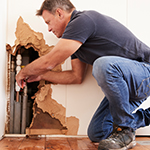Cold temperatures can cause water pipes to freeze and cause the pipe to burst and likely lead to serious flooding, if no one is home. The best prevention against frozen pipes is to keep them warm enough to stay above the freezing point. Here’s four simple tips to help.
Turn up your heat. Now is not the time to reduce home temperatures.
Open bathroom and/or kitchen cabinets. If your sinks are near an outside wall, it’s a good idea to leave your cabinet doors open so that warmer room temperatures can flow into area.
Allow the faucets to drip. Water moving through your water lines should prevent the line from freezing.
Use a space heater. A space heater in rooms that are prone to frozen water lines, but make sure you’re home when using. Do not leave unattended.

